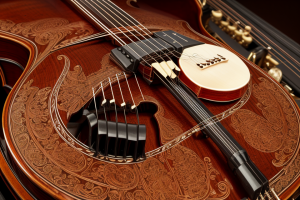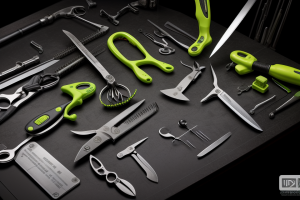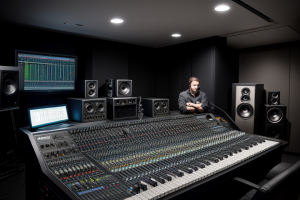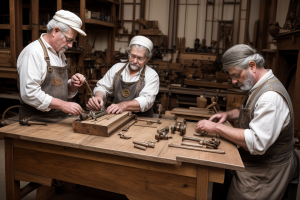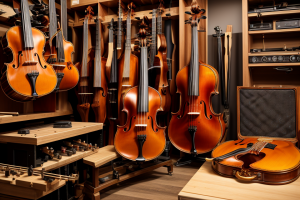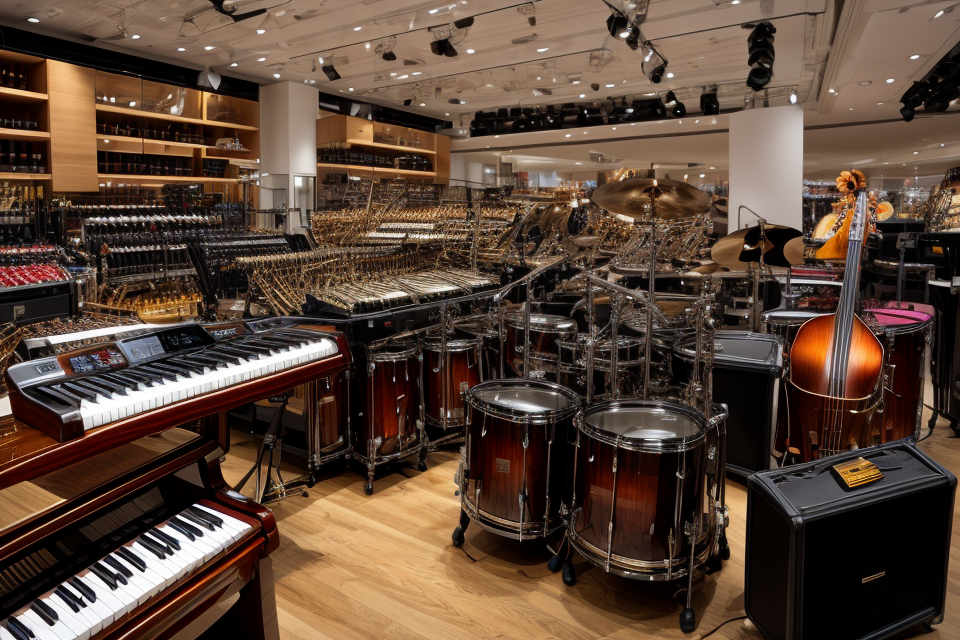
The classification of musical instruments as consumer goods has been a topic of debate for quite some time now. While some argue that musical instruments are not just mere consumer goods, others believe that they can be classified as such. This debate raises some important questions, such as whether the purpose of musical instruments is solely for personal consumption or if they have a greater cultural significance. In this article, we will explore both sides of the argument and provide a comprehensive analysis of the classification of musical instruments as consumer goods. Join us as we delve into the world of music and consumerism to uncover the truth behind this fascinating topic.
What are Musical Instruments?
Definition and Types
Musical instruments are objects or devices designed to produce sound in response to a musician’s input. They come in a wide variety of forms, each with its own unique characteristics and capabilities.
In general, musical instruments can be classified into several broad categories based on their primary function or the type of sound they produce. These categories include:
- Strings: Instruments that produce sound by vibrating strings, such as violins, cellos, and guitars.
- Woodwinds: Instruments that produce sound by blowing air across a mouthpiece, such as flutes, clarinets, and saxophones.
- Brass: Instruments that produce sound by buzzing the lips into a mouthpiece, such as trumpets, trombones, and French horns.
- Percussion: Instruments that produce sound by striking or shaking them, such as drums, cymbals, and maracas.
- Keyboard: Instruments that produce sound by pressing keys, such as pianos and organs.
- Electronic: Instruments that produce sound electronically, such as synthesizers and electric guitars.
Each of these categories contains a wide range of specific instruments, each with its own unique features and capabilities. For example, within the category of strings, there are violins, violas, cellos, and double basses, each with different sizes, shapes, and tonal characteristics. Similarly, within the category of percussion, there are many different types of drums, cymbals, and other instruments, each with its own unique sound and playing technique.
Understanding the different types of musical instruments is important for a number of reasons. For one, it can help musicians choose the right instrument for their particular style of music or playing technique. It can also help music historians and ethnographers understand the cultural and historical significance of different instruments in different societies. And for those interested in the business side of music, understanding the different types of instruments can help inform decisions about which instruments to produce, market, and sell.
Importance in Music and Culture
Musical instruments have played a vital role in music and culture throughout history. They have been used in various forms of music, from classical to contemporary, and have helped shape the way people experience and create music. The following are some of the reasons why musical instruments are so important in music and culture:
Cultural Significance
Musical instruments have been used in various cultures as symbols of power, prestige, and status. For example, in some cultures, musical instruments were used in religious ceremonies and were considered sacred objects. In other cultures, musical instruments were used to entertain royalty and the wealthy elite. As a result, musical instruments have become associated with power, prestige, and status, and they continue to hold cultural significance in many societies today.
Expression and Emotion
Musical instruments have been used as a means of expression and communication of emotions. They allow musicians to convey feelings and emotions that may be difficult to express through words alone. For example, a musician may use a guitar to express sadness or a violin to express joy. Musical instruments have also been used in therapy to help people deal with emotional and psychological issues.
Technological Advancements
Musical instruments have been the subject of technological advancements throughout history. From the development of the piano in the 18th century to the creation of electronic instruments in the 20th century, musical instruments have continued to evolve and adapt to changing times. Technological advancements have allowed musicians to create new sounds and styles, and have helped to expand the possibilities of music.
Educational Value
Musical instruments have educational value and can be used to teach people about music theory, history, and culture. They can also be used as a tool for learning other subjects, such as math, science, and language. In addition, playing musical instruments has been shown to have cognitive benefits, such as improved memory and attention skills.
Overall, musical instruments have played a significant role in music and culture throughout history. They have been used to express emotions, convey cultural significance, drive technological advancements, and educate people about music and other subjects. As such, they remain an important part of the music industry and continue to shape the way people experience and create music.
The Musical Instrument Market
Size and Growth
The musical instrument market has experienced significant growth in recent years, with a steady increase in demand for various types of instruments. This growth can be attributed to several factors, including the rising popularity of music, the growing interest in learning musical instruments, and the increasing number of musical events and performances.
One of the key drivers of the musical instrument market is the increasing popularity of music. With the widespread availability of music streaming services and the proliferation of social media platforms, more people are discovering and enjoying music than ever before. This has led to a greater interest in learning musical instruments and playing music, driving up demand for a wide range of instruments.
Another factor contributing to the growth of the musical instrument market is the increasing number of musical events and performances. From concerts and festivals to school music programs and community events, there are now more opportunities than ever for people to enjoy and participate in music. This has created a need for a wide range of musical instruments, from guitars and drums to pianos and wind instruments.
In addition to these factors, the growing interest in learning musical instruments has also contributed to the growth of the market. More people are seeking out opportunities to learn music and play instruments, whether for personal enjoyment or as part of a career in music. This has led to an increase in demand for a wide range of instruments, from beginner-friendly models to professional-grade instruments.
Overall, the musical instrument market has experienced significant growth in recent years, driven by a combination of factors including the increasing popularity of music, the growing number of musical events and performances, and the rising interest in learning musical instruments. As the market continues to expand, it is likely that demand for a wide range of instruments will continue to grow, creating new opportunities for manufacturers and retailers alike.
Segmentation and Target Demographics
In order to effectively analyze the classification of musical instruments as consumer goods, it is essential to understand the market for these products. This includes segmentation and target demographics, which can provide insight into the various groups of consumers who purchase musical instruments and the factors that influence their purchasing decisions.
Age
One key factor in musical instrument market segmentation is age. Different age groups may have different preferences and needs when it comes to musical instruments, with younger musicians often requiring more affordable and beginner-friendly options, while older musicians may be more interested in high-end, professional-grade instruments.
Skill Level
Another important factor in segmentation is skill level. Beginner musicians may require simpler, more affordable instruments, while professional musicians may be willing to invest in more expensive instruments that offer greater performance capabilities.
Genre
The genre of music being played can also influence the type of instrument that is purchased. For example, a musician playing classical music may prefer a violin or cello, while a musician playing rock or pop music may prefer a guitar or drum set.
Budget
Budget is another key factor in musical instrument purchasing decisions. Some consumers may be willing to spend more money on high-end instruments, while others may be more price-sensitive and opt for more affordable options.
By understanding these different segmentation factors, manufacturers and retailers can better tailor their product offerings and marketing strategies to meet the needs and preferences of different consumer groups.
Factors Affecting the Classification of Musical Instruments as Consumer Goods
Cost and Pricing
When it comes to classifying musical instruments as consumer goods, one of the most significant factors to consider is the cost and pricing of these instruments. The cost and pricing of musical instruments can vary greatly depending on a number of different factors, including the type of instrument, the brand, the materials used, and the level of craftsmanship involved.
In general, musical instruments can be divided into two main categories: consumer-grade instruments and professional-grade instruments. Consumer-grade instruments are typically less expensive and are designed for hobbyists or casual players, while professional-grade instruments are more expensive and are designed for serious musicians or professionals.
The cost and pricing of musical instruments can also be influenced by market demand and competition. In markets where there is high demand for musical instruments, prices may be higher due to limited supply or increased competition among manufacturers. On the other hand, in markets where there is low demand, prices may be lower as manufacturers compete for a smaller customer base.
In addition to the cost and pricing of the instrument itself, other factors such as taxes, shipping, and insurance can also impact the overall cost of owning a musical instrument. As a result, it is important for consumers to carefully consider their budget and financial resources when purchasing a musical instrument, as well as to research the various options available to them in order to make an informed decision.
Quality and Durability
Musical instruments, as consumer goods, are often judged by their quality and durability. These factors are crucial in determining the longevity and overall performance of the instrument. A well-made instrument can withstand the test of time and provide consistent, high-quality sound, while a poorly made instrument may break easily or produce subpar sound.
The quality of a musical instrument is determined by various factors, including the materials used in its construction, the craftsmanship of the maker, and the design of the instrument. High-quality materials such as solid wood, metal, or plastic can significantly impact the sound and durability of the instrument. The craftsmanship of the maker also plays a significant role in determining the quality of the instrument. A skilled maker can create an instrument that produces a rich, full-bodied sound and withstands the test of time.
Durability is another crucial factor in determining the quality of a musical instrument. A durable instrument can withstand the wear and tear of regular use and continue to produce high-quality sound over an extended period. Instruments made from high-quality materials and constructed with care can last for many years, providing musicians with a reliable and consistent tool for creating music.
However, it is important to note that the quality and durability of a musical instrument are not the only factors that determine its classification as a consumer good. Other factors, such as brand reputation, price, and consumer demand, also play a significant role in the classification of musical instruments as consumer goods.
Overall, the quality and durability of a musical instrument are essential factors in determining its classification as a consumer good. A well-made instrument can provide musicians with a reliable and consistent tool for creating music, while a poorly made instrument may break easily or produce subpar sound. The quality and durability of a musical instrument are determined by various factors, including the materials used in its construction, the craftsmanship of the maker, and the design of the instrument.
Branding and Marketing
In the realm of consumer goods, branding and marketing play a crucial role in determining the classification of musical instruments. These two factors work hand in hand to influence the consumer’s perception of the product, ultimately determining its status as a consumer good.
Branding
Branding refers to the process of creating a unique identity for a product or service, which includes the name, logo, design, and packaging. In the case of musical instruments, branding plays a significant role in shaping the consumer’s perception of the product. Brands such as Gibson, Fender, and Yamaha have become synonymous with high-quality musical instruments, and their names alone evoke a sense of trust and reliability among musicians and music enthusiasts.
Moreover, branding also influences the perceived value of a musical instrument. A well-established brand with a strong reputation is likely to command a higher price point than a lesser-known brand, even if the quality of the instrument is similar. This is because consumers are often willing to pay a premium for a product that they perceive to be of higher quality or more prestigious.
Marketing
Marketing, on the other hand, involves promoting and selling a product to the target audience. In the case of musical instruments, marketing efforts can range from traditional advertising and sales promotions to more modern tactics such as social media marketing and influencer partnerships.
Effective marketing can help to create a demand for a particular musical instrument, making it more likely to be classified as a consumer good. For example, if a particular guitar model becomes popular due to a successful marketing campaign, it is more likely to be considered a consumer good, as consumers will be more inclined to purchase it based on its perceived desirability.
In addition, marketing can also influence the perceived value of a musical instrument by creating a sense of scarcity or exclusivity. Limited edition models or collaborations with famous musicians can create a buzz around a particular instrument, making it more desirable and valuable in the eyes of consumers.
In conclusion, branding and marketing play a critical role in determining the classification of musical instruments as consumer goods. A strong brand and effective marketing efforts can help to create a demand for a particular instrument, influence its perceived value, and ultimately shape the consumer’s perception of the product.
Legal and Ethical Considerations
Intellectual Property Rights
Musical instruments, like any other consumer goods, are subject to intellectual property rights (IPR) laws. IPR laws protect the creators of musical instruments by granting them exclusive rights to their creations. This means that only the creator or the assignee of the intellectual property has the right to manufacture, sell, and distribute the instrument.
One of the most important IPR laws related to musical instruments is the design patent. A design patent protects the visual appearance of a product, including its shape, form, and ornamentation. This means that if a musical instrument has a unique design that is not common in the industry, the creator can apply for a design patent to protect it.
Another important IPR law related to musical instruments is the trademark law. A trademark is a symbol, word, or phrase that represents a company or product and distinguishes it from others. Trademarks can be used to protect the name of a musical instrument, its logo, or any other distinctive mark associated with the instrument.
In addition to design patents and trademarks, copyright laws also protect musical instruments. Copyright laws protect the creative expression of an artist, including the music and lyrics of a song. In some cases, the arrangement of a musical composition can also be protected by copyright law.
Overall, IPR laws play a crucial role in protecting the rights of musical instrument creators and ensuring that their creations are not infringed upon by others.
Environmental Impact
Musical instruments, as consumer goods, have an environmental impact that must be considered in the classification process. The environmental impact of musical instruments is influenced by various factors, including the materials used in their construction, their manufacturing processes, and their disposal or recycling methods.
One of the most significant environmental impacts of musical instruments is the use of materials in their construction. Many musical instruments are made from wood, which is a renewable resource, but the logging and processing of wood can have significant environmental consequences, such as deforestation, habitat destruction, and greenhouse gas emissions. In addition, the use of other materials, such as plastics and metals, can also have significant environmental impacts, particularly when they are non-biodegradable or difficult to recycle.
Another factor that contributes to the environmental impact of musical instruments is their manufacturing processes. The production of musical instruments often involves the use of energy-intensive processes, such as cutting, shaping, and gluing. These processes can generate significant amounts of greenhouse gas emissions, contributing to climate change.
Finally, the disposal or recycling of musical instruments can also have environmental impacts. Musical instruments can be made from a variety of materials, including wood, metal, and plastic, which can have different recycling or disposal requirements. In addition, the process of disposing of or recycling musical instruments can generate waste and pollution, which can have negative environmental impacts.
In conclusion, the environmental impact of musical instruments as consumer goods must be considered in the classification process. The use of materials, manufacturing processes, and disposal or recycling methods can all have significant environmental consequences, and it is important to consider these factors when classifying musical instruments as consumer goods.
Labor Practices
Importance of Labor Practices in the Musical Instrument Industry
In the musical instrument industry, labor practices play a crucial role in ensuring that products are manufactured under fair and ethical conditions. This is particularly important given the global nature of the industry, with musical instruments being produced in various countries around the world. Labor practices can impact a company’s reputation, brand image, and customer loyalty, and failure to comply with labor laws and regulations can result in legal and financial consequences.
Labor Laws and Regulations in the Musical Instrument Industry
The musical instrument industry is subject to various labor laws and regulations, including minimum wage laws, overtime laws, safety regulations, and anti-discrimination laws. These laws vary by country and region, and companies must ensure that they comply with all applicable laws and regulations. Failure to do so can result in legal penalties, fines, and reputational damage.
Responsible Sourcing and Supply Chain Management
Responsible sourcing and supply chain management are critical aspects of labor practices in the musical instrument industry. Companies must ensure that the materials used to manufacture their products are sourced ethically and sustainably, and that the workers involved in the production process are treated fairly and paid a living wage. This includes ensuring that workers are not subject to forced labor, child labor, or other forms of exploitation.
Monitoring and Compliance
To ensure compliance with labor laws and regulations, companies must establish effective monitoring systems to identify and address any labor violations. This includes conducting regular audits of suppliers and manufacturers, interviewing workers, and reviewing documentation related to labor practices. Companies must also establish a system for reporting and addressing any labor violations that are identified.
Consequences of Non-Compliance
Non-compliance with labor laws and regulations can have serious consequences for companies in the musical instrument industry. This includes legal penalties, fines, and reputational damage, which can impact sales and customer loyalty. In addition, companies may face boycotts or protests from customers and advocacy groups, which can further damage their brand image and financial performance.
The Role of Certification and Labeling
Certification and labeling programs can help companies demonstrate their commitment to responsible labor practices in the musical instrument industry. These programs typically involve independent third-party audits and certification of companies’ labor practices, which can provide assurance to customers that the products they purchase are manufactured under fair and ethical conditions.
Overall, labor practices are a critical aspect of the musical instrument industry, and companies must ensure that they comply with all applicable laws and regulations. By establishing effective monitoring systems, sourcing materials ethically and sustainably, and demonstrating their commitment to responsible labor practices through certification and labeling programs, companies can build trust with customers and stakeholders, protect their brand image, and ensure long-term success in the industry.
Recap of Key Points
- Definition of Consumer Goods: Consumer goods are products that are designed and produced for the end-user, intended for personal or household use. Musical instruments are classified as consumer goods because they are designed for individual use, as opposed to industrial or commercial use.
- Product Liability: Manufacturers and sellers of consumer goods have a legal responsibility to ensure that their products are safe and do not pose a risk of harm to consumers. This applies to musical instruments as well, and manufacturers and sellers must ensure that their products meet safety standards and are free from defects.
- Intellectual Property Rights: Intellectual property rights, such as patents and trademarks, play an important role in the music industry. Manufacturers and sellers of musical instruments must respect and comply with these rights, to avoid infringement and legal consequences.
- Ethical Considerations: The production and sale of musical instruments raise ethical concerns related to sustainability, cultural preservation, and social responsibility. Manufacturers and sellers must consider these issues when designing, producing, and marketing their products.
- Consumer Protection Laws: Consumer protection laws aim to ensure that consumers are treated fairly and protected from deceptive or unfair practices. These laws apply to the sale of musical instruments, and manufacturers and sellers must comply with them to avoid legal consequences.
- Product Safety Standards: Musical instruments must meet safety standards to ensure that they are safe to use. Manufacturers and sellers must comply with these standards to avoid legal consequences and to ensure the safety of their customers.
- Warranties and Returns: Manufacturers and sellers of musical instruments must provide warranties and return policies to protect the interests of their customers. These policies must be clearly communicated and adhered to in order to maintain customer trust and avoid legal disputes.
Future Outlook and Trends
The Growing Importance of Intellectual Property Rights in the Music Industry
The music industry has witnessed a significant shift towards intellectual property rights (IPR) in recent years. With the advent of digital technology, it has become increasingly challenging to protect musical works and creations. The emergence of online platforms and streaming services has led to a proliferation of unauthorized distribution and piracy, making it crucial for musicians and music producers to safeguard their rights.
The Impact of E-commerce on the Sales and Distribution of Musical Instruments
E-commerce has revolutionized the way musical instruments are sold and distributed. Online marketplaces and specialized websites have provided a platform for manufacturers, retailers, and consumers to connect, offering a wide range of products at competitive prices. This shift towards digital sales channels has enabled greater accessibility and convenience for customers, while also facilitating the global reach of musical instruments.
The Emergence of Personalized and Customized Musical Instruments
The growing demand for personalized and customized musical instruments is an emerging trend in the industry. Consumers are increasingly seeking unique and tailored products that reflect their individuality and style. This trend has led to the development of new technologies and manufacturing techniques, enabling greater flexibility and creativity in the design and production of musical instruments.
The Influence of Social Media and Influencer Marketing on Musical Instrument Consumption
Social media has played a significant role in shaping consumer preferences and behavior when it comes to musical instruments. Influencer marketing has emerged as a powerful tool for manufacturers and retailers to promote their products and reach new audiences. Social media platforms like Instagram and YouTube have become hubs for musical instrument enthusiasts to share their experiences, opinions, and recommendations, influencing the choices of other consumers.
The Growing Importance of Sustainability and Environmental Consciousness in Musical Instrument Production
Environmental consciousness and sustainability are becoming increasingly important in the production of musical instruments. As consumers become more aware of the environmental impact of their purchases, manufacturers are under pressure to adopt eco-friendly practices and materials. This trend is driving innovation in materials science and manufacturing processes, with a focus on reducing waste, minimizing carbon footprint, and promoting sustainable growth.
FAQs
1. What is the definition of a consumer good?
A consumer good is a product that is bought by individuals for personal use or consumption, rather than for further production or resale. In other words, it is a tangible product that is meant to satisfy a consumer’s want or need.
2. What are some examples of consumer goods?
Some examples of consumer goods include clothing, electronics, furniture, and food products. These are all items that are typically purchased by individuals for personal use or consumption.
3. Are musical instruments considered consumer goods?
Yes, musical instruments can be considered consumer goods. They are products that are bought by individuals for personal use or consumption, rather than for further production or resale. People buy musical instruments to play music, whether it be for personal enjoyment or as part of a professional career.
4. Why is it important to classify musical instruments as consumer goods?
Classifying musical instruments as consumer goods helps to understand their role in the economy and the ways in which they are consumed by individuals. This information can be useful for businesses that manufacture or sell musical instruments, as well as for researchers and policymakers who are interested in the music industry.
5. What are some factors that influence the classification of musical instruments as consumer goods?
There are several factors that can influence the classification of musical instruments as consumer goods. These include the price of the instrument, the intended use of the instrument, and the perceived value of the instrument to the consumer. Additionally, cultural and societal factors can also play a role in how musical instruments are classified and consumed.
6. How do the characteristics of musical instruments affect their classification as consumer goods?
The characteristics of musical instruments, such as their durability, functionality, and aesthetic appeal, can all affect their classification as consumer goods. For example, a high-quality, durable instrument that is designed for professional use may be classified differently than a lower-priced, entry-level instrument that is intended for beginner musicians.
7. How does the market for musical instruments differ from other consumer goods markets?
The market for musical instruments can differ from other consumer goods markets in several ways. For example, the price of musical instruments can vary widely depending on the type of instrument and its quality, and there may be a greater emphasis on the emotional and sentimental value of musical instruments compared to other consumer goods. Additionally, the market for musical instruments may be more specialized and niche-focused compared to other consumer goods markets.


